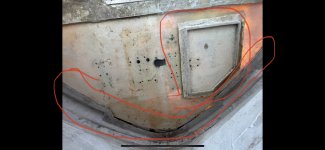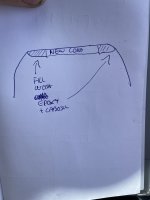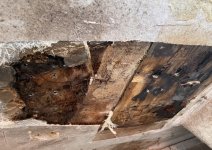Thanks everyone for the advise, I’m definitely going to cut then prime with neat epoxy what would you expect it to take 2 coats or is it case of keep putting it on till it won’t take no more ? , also if I could stuff the foam and the wood into the lip poss by grinding the edges of the wood and foam down a bit and ramming it in with thickened epoxy (don’t know if I’m going to be able to do it till the foam comes ) would that be better than stuffing the edge with pb ? If i do go down the route of stuffing the edge with pb will it create a hard spot or is it not worth worrying about ?
Should the join between the wood and the foam, or any joins between foam and foam be butted up or should I leave something like a 1/8” gap and fill that with thickened epoxy?
One more question should I use pb ( epoxy with cabosil and chop strands )to stick the core to the inside of the deck or use just thickened epoxy with cabosil? I can prop the core into place easily enough
Sorry for all the questions
Thanks Nick
Thanks everyone for the advise, I’m definitely going to cut then prime with neat epoxy what would you expect it to take 2 coats
**2 coats are fine nough. Just make sure edges get saturated
or is it case of keep putting it on till it won’t take no more ? , also if I could stuff the foam and the wood into the lip poss by grinding the edges of the wood and foam down a bit and ramming it in with thickened epoxy (don’t know if I’m going to be able to do it till the foam comes ) would that be better than stuffing the edge with pb ? If i do go down the route of stuffing the edge with pb will it create a hard spot or is it not worth worrying about ?
** Just fill with pb as discussed. Force it in. Poke it to let out air bubbles and go at it again. Foam will probably degrade quickly.
Should the join between the wood and the foam, or any joins between foam and foam be butted up or should I leave something like a 1/8” gap and fill that with thickened epoxy?
** No foam at all.
One more question should I use pb ( epoxy with cabosil and chop strands )to stick the core to the inside of the deck or use just thickened epoxy with cabosil? I can prop the core into place easily enough
** Always use chop strand to make pb. Cabosil is your thickener, chopped strand is your strength. When making the pb determine your resin amount then drop the chopped strand in and let it soak until it falls to the bottom, then add hardener, then add cabosil to thickness desired. I use a drill with a small paint paddle. The mix nearly doubles from original when finished so keep that in mind. Try small batches until you feel comfortable. You want to pull the paddle out, look at the mix and make sure the mix is stiff.
Like the swirls don't drop or hold the stuff upside down and doesn't drop.
Pics man pics!
Poly or poxy is a matter of choice.


























